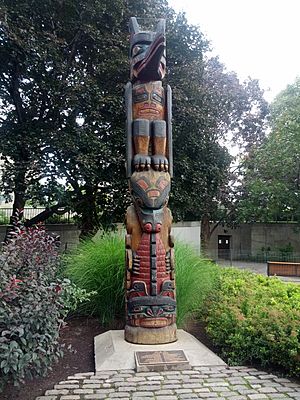Totemism facts for kids

Totemism is a special belief that connects people with nature. The word "totem" comes from the Ojibwe language, meaning "a relative of mine." A trader named James Long first wrote about it in 1791. This belief has been found in many native groups in America, Africa, and Australia. People who study different ethnic groups have learned a lot about it. Often, a group's totem is an animal or a plant. These totems are shown on special objects and belong only to that group.
Contents
What is Totemism?
Totemism is a way that certain groups of people understand their connection to the natural world. It's a belief system where a group, like a family or a clan, feels a special bond with a particular animal, plant, or natural object. This animal or plant is called their totem. It's often seen as a protector or a symbol of their group.
Early Ideas About Totemism
In the 1800s, many European thinkers saw totemism as a very old or "primitive" religion. They thought it was linked to rules about food and things that were taboo (forbidden). Some early thinkers believed that these ideas came from native groups not understanding the difference between humans and animals. However, modern experts no longer believe this is true.
Totem Poles
Totem poles are tall, carved poles made from large trees, like cedar or spruce. Native groups in northwest North America, including Alaska, create them. These poles are not for worship. Instead, they tell important stories about the clan they belong to.
What Totem Poles Show
On a totem pole, you might see carvings of eagles or ravens at the very top. Lower down, there can be beavers, foxes, bears, and frogs. Sometimes, a carving of a person is placed at the top. This figure is often called the watchman, who warns the village about danger. Early missionaries sometimes had these poles burned because they misunderstood their purpose. They didn't realize the poles were like storybooks carved in wood.
How People Studied Totemism
Many thinkers have tried to understand totemism. Two important people were Émile Durkheim and Claude Lévi-Strauss.
Durkheim's View
In 1915, a thinker named Émile Durkheim suggested that totemism was a way for groups in society to understand themselves. He studied Aboriginal Australian clans. Each clan had its own totem, which could be an animal, plant, or even a river. These totems and their symbols were respected and protected. This was because people believed that if their totem was healthy, their clan would also be healthy. Durkheim thought that respecting the totems was a way for the clan to respect itself.
Lévi-Strauss's View
Later, in 1962, Claude Lévi-Strauss wrote a book called Totemism. He said that totemism is a way humans sort people into different groups. When a group has rules, like exogamy (meaning you can't marry someone from your own group), it's important to show how one clan is different from another. Humans don't have different features like wolves or birds do. So, giving a clan the identity of an animal makes its members clearly different. This helps create social boundaries between groups.
Images for kids
-
Personal totem of Mohegan Chief Tantaquidgeon, commemorated on a plaque at Norwich, Connecticut
-
A totem pole in Thunderbird Park, Victoria, British Columbia
See also
 In Spanish: Tótem para niños
In Spanish: Tótem para niños


